Loading... # MemCached 编译安装部署、LRU算法、分布式算法剖析 ## 1. 编译安装 Memcached 服务端 > [libevent 官方下载渠道](https://libevent.org/) > [Memcache 官方下载渠道](https://memcached.org/downloads) ```shell [vagrant@centos7 ~]$ wget https://github.com/libevent/libevent/releases/download/release-2.1.10-stable/libevent-2.1.10-stable.tar.gz [vagrant@centos7 ~]$ tar -zxvf libevent-2.1.10-stable.tar.gz [vagrant@centos7 ~]$ cd libevent-2.1.10-stable [vagrant@centos7 libevent-2.1.10-stable]$ ./configure --prefix=/usr/local [vagrant@centos7 libevent-2.1.10-stable]$ make [vagrant@centos7 libevent-2.1.10-stable]$ sudo make install [vagrant@centos7 ~]$ wget https://memcached.org/files/memcached-1.5.16.tar.gz [vagrant@centos7 ~]$ tar -zxvf memcached-1.5.16.tar.gz [vagrant@centos7 ~]$ cd memcached-1.5.16/ [vagrant@centos7 memcached-1.5.16]$ ./configure --prefix=/usr/local/memcached [vagrant@centos7 memcached-1.5.16]$ make [vagrant@centos7 memcached-1.5.16]$ sudo make install [vagrant@centos7 memcached-1.5.16]$ ln -s /usr/local/lib/libevent-2.1.so.6 /usr/lib64/libevent-2.1.so.6 [vagrant@centos7 bin]$ /usr/local/memcached/bin/memcached -d -m 128 -u root -p 11211 ``` ## 2. PHP 安装拓展 memcache > 详细教程可看 https://www.php.net/manual/en/memcache.installation.php > 可以使用 [pecl](https://pecl.php.net/package/memcache) 安装或者编译安装,pecl 的源只支持 php5 > [Github-PHP7-memcache](https://github.com/websupport-sk/pecl-memcache) ```shell [vagrant@lnmp-new ~]$ git clone https://github.com/websupport-sk/pecl-memcache [vagrant@lnmp-new ~]$ cd pecl-memcache/ [vagrant@lnmp-new pecl-memcache]$ /usr/local/php7/bin/phpize [vagrant@lnmp-new pecl-memcache]$ ./configure --enable-memcache --with-php-config=/usr/local/php7/bin/php-config [vagrant@lnmp-new pecl-memcache]$ sudo make && make install [vagrant@lnmp-new pecl-memcache] sudo cp memcache.so /usr/local/php7/lib/php/extensions/no-debug-non-zts-20180731/ [vagrant@lnmp-new pecl-memcache] vi /usr/local/php7/lib/php.ini #增加以下两句 extension_dir = "/usr/local/php7/lib/php/extensions/no-debug-non-zts-20180731" extension = "memcache.so" #查看是否启用 [vagrant@lnmp-new] systemctl php-fpm restart [vagrant@lnmp-new] php -m | grep memcache ``` ## 3. memcached 如何支持高并发 > memcache 支持多路复用 I/O 模型(如 epoll,select 等)。传统阻塞 I/O 中,系统可能会因为某个用户连接还没做好 I/O 准备而一直等待,知道这个连接做好 I/O 准备,如果这时有其他用户连接到服务器,很可能会因为系统阻塞而得不到响应。 > > 而多路复用 I/O 是一种消息通知模式,用户连接做好 I/O 准备后,系统会通知我们这个连接可以进行,这样就不会阻塞在某个用户连接。因此,Memcached 才能支持高并发。 ## 4. memcached 使用 LRU 算法淘汰数据 > LRU (Least Recently Used) ```c it = slabs_alloc(ntotal,id); // 申请内存失败,就开始淘汰数据 if (it == 0){ int tries = 50; ... //从尾部开始遍历 for (search = tails[id];tries > 0 && search != NULL;tries--,search = search->prev){ // 如果引用次数为 0,就释放掉 if(search ->refcount == 0){ ... do_item_unlink(search); break; } } // 再次申请内存,可能都有引用了 it = slabs_alloc(ntotal,id); if (it == 0){ tries = 50; for(search = tails[id];tries > 0 && search != NULL; tries--,search = search ->prev){ //查找三小时没有访问过的数据,然后将它引用设置为零,再释放掉 if (search ->refcont != 0 && search->time + 10800 < current_time){ search->refcount =0; do_item_unlink(search); break; } } //如果还是申请不到内存,那么久返回 NULL it = slabs_alloc(ntotal,id); if(it == 0){ return NULL; } } } ``` ## 5. memcached 多线程模型 > 主线程:接受客户端连接,并把连接分配给工作线程处理 > 工作线程:处理客户端连接的请求 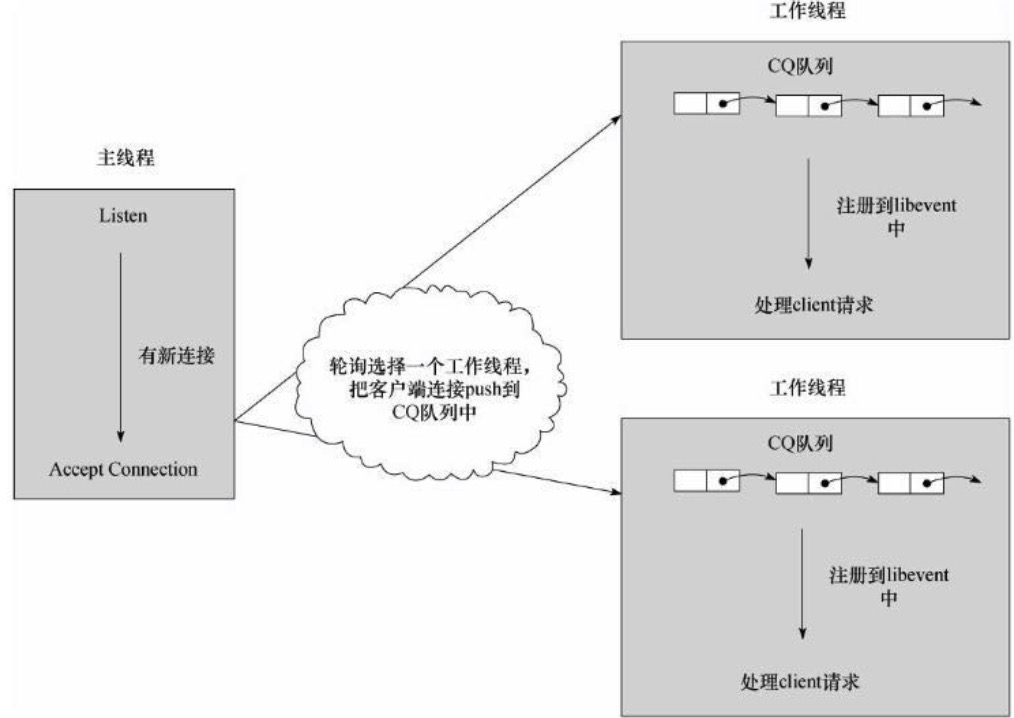 > 主线程监听客户端,客户端连接 memcached 时,memcached调用 accept 函数接收到来的连接,然后 push 到工作线程的 CQ 队列,并给工作线程发一个信号,通知工作线程有新的客户端连接需要处理 > > 当工作线程收到主线程的信号,便会把 CQ 队列的客户端链接注册到 libevent 进行监听,libevent 就会侦听客户端连接的读写事件,并调用相关的回调函数。 ## 6. memcached 分布式布置方案 > 如果要布置多台 memcached 服务器,怎样确定一个数据应该保存到哪台服务器上面? > 有两种方案:第一种是普通的 Hash 分布,第二种是一致性的 Hash 分布。 ### a) 普通的 Hash 分布 ```php function mHash($key) { $md5 = substr(md5($key),0,8); $seed = 31; $hash = 0; for ($i=0;$i<8;$i++){ $hash = $hash * $seed + ord($md5($i)); $i ++; } return $hash ; } $sercers = array( array( "host"=>'192.168.1.12',"port"=>6397 ) array( "host"=>'192.168.1.14',"port"=>6397 ) ); $key = "name"; $value = 'biyongyao'; $sc = $server[mHash($key)%2]; $memcached = new Memcached($sc); $memcached->set($key,$value); ``` > 如果服务器不发生改变,这种方法很好地运行 > 如果增加一台服务器,那么 key 经过 hash 之后和之前的服务器对不上了,这就导致了市局丢失,那么就需要使用一致性 Hash 分布 ### b)一致性 Hash 分布 ```php $key1 = mHash('key1'); $key2 = mHash('key2'); $key3 = mHash('key3'); $key4 = mHash('key4'); $server1 = mHash('192.168.1.1'); $server2 = mHash('192.168.1.2'); $server3 = mHash('192.168.1.3'); ``` 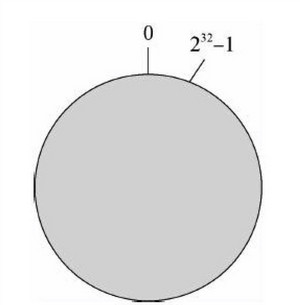 > 将 32 位的整数(0 到 2^31 -1)想象成一个圆环,0 是开头,2^31 -1 是尾 --- 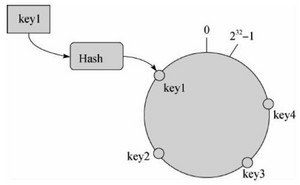 > 把四个 key 经过 mhash 整成整数,然后在圆环给它一个位置 --- 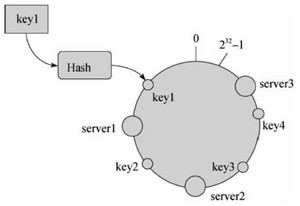 > 把三台服务器放到环中 --- 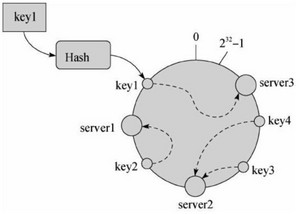 > 以逆时针开始划分,把相应的 key 保存到服务器上 > key4,key3 属于 server2,key2 属于 server1,key1 属于 server3 ---  > 如果 server2 发生故障,那么开始属于 server2 的 key3 和 key4 就归属 server1 管 --- 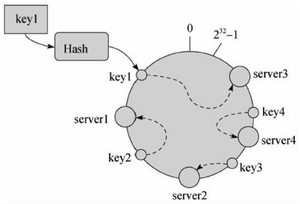 > 如果新增一台服务器放在 key3 和 key4 之间,那么原来属于 server2 的 key4 就归属 server4 管 --- ### c) 一致性 Hash 分布算法的实例 ```php /** * memcache 分布式算法,一致性 hash * Class FlexiHash */ class FlexiHash { use hashTools; private $serverList = array(); private $isSorted = false; public function addServer($server) { $hash = $this->mHash1($server); if ( !isset($this->serverList[$hash])) { $this->serverList[$hash] = $server; } $this->isSorted = false; return true; } public function removeServer($service) { $hash = $this->mHash1($service); if (isset($this->serverList[$hash])) { unset($this->serverList[$hash]); } $this->isSorted = false; return true; } public function lookup($key) { $hash = $this->mHash1($key); if ( !$this->isSorted) { krsort($this->serverList, SORT_NUMERIC); $this->isSorted = true; } foreach ($this->serverList as $pos => $server) { if ($hash >= $pos) { return $server; } } return end($this->serverList); } } ``` ### d) 测试一致性算法 ```php $hashServer = new FlexiHash(); $hashServer->addServer('192.168.1.1'); $hashServer->addServer('192.168.1.2'); $hashServer->addServer('192.168.1.3'); $hashServer->addServer('192.168.1.4'); echo 'save key1 in server:',$hashServer->lookup('key1').PHP_EOL; echo 'save key2 in server:',$hashServer->lookup('key2').PHP_EOL; echo '####################'.PHP_EOL; $hashServer->removeServer('192.168.1.2'); echo 'save key3 in server:',$hashServer->lookup('key3').PHP_EOL; echo 'save key4 in server:',$hashServer->lookup('key4').PHP_EOL; echo '####################'.PHP_EOL; $hashServer->addServer('192.168.1.6'); echo 'save name in server:',$hashServer->lookup('name').PHP_EOL; echo 'save girl in server:',$hashServer->lookup('girl').PHP_EOL; ```  > 结果可看,一致性 hash 算法只会改变很少一部分的数据,从而减少了数据丢失的情况 © Allow specification reprint Support Appreciate the author AliPayWeChat Like If you think my article is useful to you, please feel free to appreciate